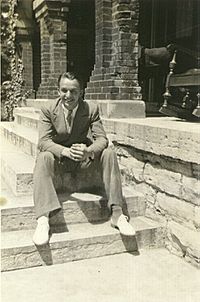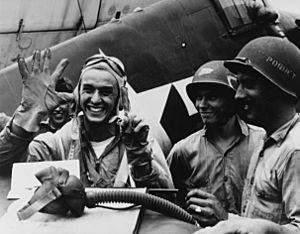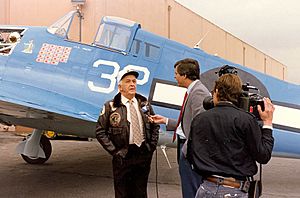Alexander Vraciu facts for kids
Quick facts for kids
Alexander Vraciu
|
|
|---|---|
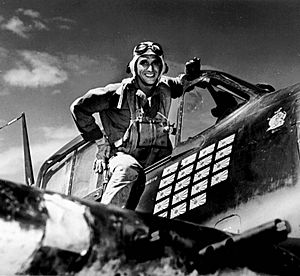
Lieutenant Alexander Vraciu in his Grumman F6F Hellcat after the "Mission Beyond Darkness" during the Battle of the Philippine Sea (June 20, 1944)
|
|
| Born | November 2, 1918 East Chicago, Indiana, United States |
| Died | January 29, 2015 (aged 96) West Sacramento, California, United States |
| Buried |
Oakmont Memorial Park, Lafayette, California
|
| Allegiance | United States |
| Service/ |
United States Navy |
| Years of service | 1941–1964 |
| Rank | Commander |
| Unit | VF-3/6 VF-16 VF-20 VF-51 |
| Battles/wars | World War II
|
| Awards | Navy Cross Distinguished Flying Cross (3) Air Medal (4) United States Navy High Individual – Aerial Gunnery – 1957 |
| Spouse(s) | Kathryn Horn |
Alexander Vraciu (born November 2, 1918 – died January 29, 2015) was a brave pilot in the United States Navy. He was known as a fighter ace during World War II. This means he shot down many enemy planes in air battles. He received the Navy Cross for his courage.
By the end of the war, Vraciu was one of the top U.S. Navy aces. He had shot down 19 enemy planes in the air. He also destroyed 21 more planes on the ground. After the war, he became a test pilot. He helped create the Naval and Marine Air Reserve program. This program trains future pilots. He retired from the Navy as a Commander in 1963. Later, he worked for Wells Fargo bank.
Vraciu was born in East Chicago, Indiana. His parents were immigrants from Romania. He went to DePauw University before joining the Navy in 1941. During World War II, he flew Grumman F6F Hellcat planes in the Pacific. For five months, he flew alongside his mentor, Edward "Butch" O'Hare. O'Hare was the Navy's first ace of the war.
Vraciu's most famous day was June 19, 1944. This day was part of the "Great Marianas Turkey Shoot." He shot down six Japanese planes in just eight minutes. He used very little ammunition to do it. In December 1944, his plane was shot down over the Philippines. He parachuted to safety. He spent five weeks with Filipino resistance fighters. Then he rejoined American forces. Vraciu spent the last part of the war at a Naval Air Test Center.
Contents
Becoming a Pilot: Early Life and Training
Alexander Vraciu was born in East Chicago, Indiana, on November 2, 1918. He was the second child and only son of Alexandru Sr. and Maria Vraciu. His parents came from Transylvania, Romania. They settled in East Chicago, where they met. When Alex was young, his family visited Romania. They wanted their children to learn about their culture. After returning to Indiana, Vraciu finished high school in 1937.
He earned a scholarship to DePauw University in Greencastle, Indiana. He studied sociology and graduated in 1941. At college, Vraciu played sports like track and football. He also decided he wanted to become a pilot. During a summer break, he joined the Civilian Pilot Training Program. He earned his private pilot's license. On October 9, 1941, he joined the U.S. Navy Reserve as a naval aviator.
Vraciu married Kathryn Horn on August 24, 1944. They had five children together. Kathryn passed away in 2003.
After joining the Navy in 1941, Vraciu began his pilot training. He trained at several Naval Air Stations. These included Glenview in Illinois, Dallas and Corpus Christi in Texas, and San Diego in California. He became a naval aviator in August 1942. He was also made an ensign.
In 1942, Vraciu heard Lieutenant Commander Edward "Butch" O'Hare speak. O'Hare was the Navy's first ace. Vraciu later got orders to join O'Hare's squadron, Fighting Squadron 3 (VF-3). The squadron learned to fly their new F6F-3 Hellcats. They practiced landing on aircraft carriers. O'Hare chose Vraciu as his wingman. He taught Vraciu important air combat skills. In July 1943, their squadron was renumbered to VF-6.
World War II: A Flying Ace
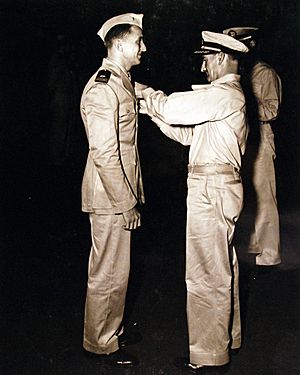
Vraciu's first air battle was over Wake Island in October 1943. He was flying from the aircraft carrier USS Independence. He scored his first victory on October 5, 1943. He and O'Hare found enemy planes. Vraciu followed a Japanese Zero to Wake Island. He shot it down while it was on the ground. He also destroyed a Japanese bomber.
On November 20, 1943, Vraciu shot down another bomber. This was during a mission in the Gilbert Islands. He had learned a special flying move from O'Hare. This move helped him avoid the enemy plane's powerful tail gun.
After his ship was damaged, Vraciu's squadron moved to USS Essex. Then they went to USS Intrepid. On January 29, 1944, Vraciu shot down three bombers. This brought his total to five enemy planes. This made him an "ace." On February 17, he shot down four Japanese fighters. This happened over Truk Atoll. He became VF-6's top ace.
When USS Intrepid went for repairs, Vraciu could have gone home. But he wanted to keep fighting. He joined VF-16 aboard USS Lexington in February 1944.
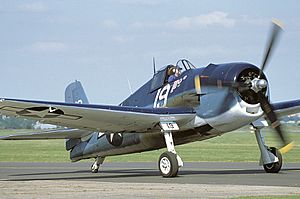
| Date | Type | Total | Citation |
|---|---|---|---|
| 10/05/43 | 1 A6M Zeke | 1 | |
| 11/20/43 | 1 Mitsubishi G4M Betty | 1 | |
| 01/29/44 | 3 G4M Betty | 3 | |
| 02/16/44 | 3 A6M Zeke, 1 Nakajima A6M2-N Rufe | 4 | |
| 04/29/44 | 2 A6M Zeke | 2 | |
| 06/14/44 | 1 G4M Betty | 1 | |
| 06/19/44 | 6 Yokosuka D4Y Judy | 6 | |
| 06/20/44 | 1 A6M Zeke | 1 | |
| 19 | |||
Vraciu's best day as a pilot was June 19, 1944. This was during the First Battle of the Philippine Sea. It was also called the "Great Marianas Turkey Shoot." Even with a broken part in his plane, he attacked Japanese dive bombers. He destroyed six of them in eight minutes. When he landed, his crew found he had used only 360 bullets. This meant each plane was shot down with very few bullets.
On June 20, 1944, Vraciu shot down his nineteenth plane. This made him the top U.S. Navy ace at the time. He was suggested for the Medal of Honor. But he received the Navy Cross instead. Vraciu went back to the United States in August 1944. He was promoted to lieutenant. He also made public appearances to support the Navy.
Vraciu returned to fighting in the Pacific in late 1944. He flew Grumman F6F Hellcats with VF-20. On December 14, 1944, his plane was hit by anti-aircraft fire. This happened during a mission over the Philippines. Vraciu parachuted out of his plane. He landed in Luzon. Filipino resistance fighters rescued him. He spent five weeks with them. Then he rejoined American forces and returned to USS Lexington.
He spent the last months of the war at the Naval Air Test Center. Vraciu ended the war as the U.S. Navy's fourth highest-ranking ace. He was credited with shooting down 19 enemy planes in the air. He also destroyed 21 on the ground.
After the War: Test Pilot and Commander
After World War II, Vraciu became a lieutenant commander. He spent six years as a test pilot. He helped create the Naval and Marine Air Reserve program. This program was important for the Navy after the war.
Vraciu later became a jet training officer. He also attended a Naval Post-Graduate School. He was promoted to commander. From 1956 to 1958, Vraciu led his own fighter squadron, VF-51. He won a gunnery championship in 1957. Vraciu retired from the U.S. Navy on December 31, 1963.
Later Years and Legacy
After leaving the Navy, Vraciu moved to Danville, California. He worked for Wells Fargo bank. In his retirement, he often gave talks to schools and groups.
Vraciu appeared on the History Channel show Dogfights in 2006. The episode was called "The Zero Killer."
He did not want to write his own book. But he agreed to be interviewed for history projects. These interviews led to a book about his life. It was called Fighter Pilot: The World War II Career of Alex Vraciu (2010).
Vraciu passed away on January 29, 2015, in West Sacramento, California. He was 96 years old.
People who knew him said Vraciu was calm and easy-going. But he was very aggressive and brave in combat. His biographer said Vraciu always gave credit to those who trained him. In March 2019, Naval Air Facility El Centro was renamed Vraciu Field in his honor.
Vraciu received many awards for his service:
 |
||
| Naval Aviator Badge | |||
| Navy Cross | Distinguished Flying Cross w/ two 5⁄16" Gold Stars |
||
| Air Medal w/ three 5⁄16" Gold Stars |
Combat Action Ribbon | Navy Presidential Unit Citation w/ two 3⁄16" bronze stars |
|
| Navy Unit Commendation | China Service Medal | American Defense Service Medal | |
| American Campaign Medal | Asiatic-Pacific Campaign Medal w/ three 3⁄16" bronze stars |
World War II Victory Medal | |
| National Defense Service Medal w/ one 3⁄16" Bronze Star |
Naval Reserve Medal | Philippine Liberation Medal w/ two 3⁄16" bronze stars |
|
- United States Navy High Individual (Aerial Gunnery), 1957
See also
 In Spanish: Alexander Vraciu para niños
In Spanish: Alexander Vraciu para niños


